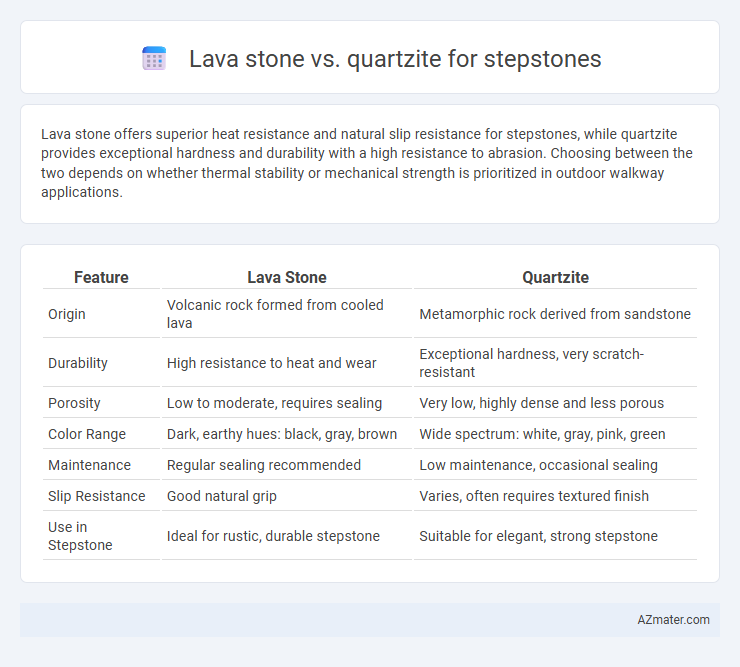Lava stone offers superior heat resistance and natural slip resistance for stepstones, while quartzite provides exceptional hardness and durability with a high resistance to abrasion. Choosing between the two depends on whether thermal stability or mechanical strength is prioritized in outdoor walkway applications.
Table of Comparison
| Feature | Lava Stone | Quartzite |
|---|---|---|
| Origin | Volcanic rock formed from cooled lava | Metamorphic rock derived from sandstone |
| Durability | High resistance to heat and wear | Exceptional hardness, very scratch-resistant |
| Porosity | Low to moderate, requires sealing | Very low, highly dense and less porous |
| Color Range | Dark, earthy hues: black, gray, brown | Wide spectrum: white, gray, pink, green |
| Maintenance | Regular sealing recommended | Low maintenance, occasional sealing |
| Slip Resistance | Good natural grip | Varies, often requires textured finish |
| Use in Stepstone | Ideal for rustic, durable stepstone | Suitable for elegant, strong stepstone |
Introduction to Lava Stone and Quartzite Stepstones
Lava stone stepstones offer exceptional durability and natural heat resistance, making them ideal for high-traffic outdoor paths and garden features. Quartzite stepstones exhibit a stunning crystalline texture with superior hardness and weather resistance, ensuring longevity and minimal maintenance in various climates. Both materials provide unique aesthetic appeal and functional benefits, catering to different design preferences and environmental conditions.
Geological Origins of Lava Stone and Quartzite
Lava stone, also known as basalt, originates from volcanic activity when molten lava rapidly cools and solidifies, forming a dense, durable igneous rock primarily composed of minerals such as pyroxene and plagioclase feldspar. Quartzite is a metamorphic rock formed when sandstone undergoes intense heat and pressure, recrystallizing quartz grains into a hard, non-foliated rock with a granular texture. The geological differences between lava stone and quartzite influence their durability, porosity, and appearance, making lava stone ideal for high-resistance steps and quartzite preferred for natural aesthetics and hardness.
Aesthetic Differences: Color and Texture Comparison
Lava stone features a rugged, porous texture with deep, earthy tones ranging from dark charcoal to reddish-brown, creating a natural, volcanic aesthetic ideal for rustic stepstone designs. Quartzite offers a smoother, more crystalline surface with vibrant color variations from white and gray to pink and green, providing a polished, elegant look suitable for refined outdoor pathways. The color and texture contrast between lava stone's matte, coarse finish and quartzite's glossy, fine-grained appearance significantly influences the visual impact and style of stepstone applications.
Durability and Weather Resistance
Lava stone offers superior durability and exceptional resistance to weathering due to its volcanic origin, making it highly resistant to cracking, chipping, and moisture absorption. Quartzite, a metamorphic rock, also provides excellent hardness and scratch resistance but is slightly more porous than lava stone, which can affect its long-term performance in harsh weather conditions. Both materials are suitable for stepstones, but lava stone typically outperforms quartzite in terms of longevity and resilience to extreme temperature fluctuations.
Slip Resistance and Safety Considerations
Lava stone offers excellent slip resistance due to its naturally porous and textured surface, making it a safe choice for stepstones in wet or outdoor environments. Quartzite, while harder and more durable, can become slippery when polished, requiring additional surface treatments to enhance safety. Selecting lava stone for stepstones prioritizes non-slip properties essential for preventing falls and ensuring secure footing in high-traffic or moisture-prone areas.
Installation Process for Lava Stone vs Quartzite Stepstones
Lava stone stepstones require fewer precautions during installation due to their lightweight nature and porous surface, allowing for quicker setting and better adhesion with standard mortar. Quartzite stepstones, being denser and heavier, demand more precise handling, specialized cutting tools, and a stronger adhesive or thin-set mortar for secure placement. The installation of quartzite often includes additional sealing to prevent staining and maintain durability, unlike lava stone which benefits from natural weather resistance.
Maintenance Requirements and Longevity
Lava stone offers exceptional durability and low maintenance, resisting stains and requiring only occasional sealing to preserve its natural look, making it ideal for high-traffic stepstones. Quartzite is equally durable but demands more frequent sealing to prevent water damage and staining, which can extend its longevity when properly maintained. Both materials provide long-lasting performance, yet lava stone generally requires less upkeep, optimizing its practicality for outdoor stepstone applications.
Cost Comparison: Lava Stone vs Quartzite
Lava stone typically costs between $10 and $30 per square foot, making it a more budget-friendly option compared to quartzite, which ranges from $20 to $60 per square foot due to its rarity and durability. The installation cost for both materials can vary, but quartzite generally demands higher labor fees because of its hardness and the precision required for cutting. Considering long-term value, quartzite offers greater resistance to scratches and heat, potentially reducing maintenance expenses despite its higher upfront cost.
Eco-Friendliness and Sustainability Factors
Lava stone exhibits high eco-friendliness due to its natural formation from volcanic activity and minimal processing requirements, resulting in lower carbon emissions compared to quartzite. Quartzite, while durable and often sourced from abundant quarries, involves more intensive mining and energy consumption, impacting sustainability. Both materials offer longevity for stepstone applications, but lava stone's reduced environmental footprint makes it a more sustainable choice in green construction projects.
Best Applications: Choosing the Right Material for Your Project
Lava stone offers exceptional durability and heat resistance, making it ideal for outdoor stepstones in high-traffic or weather-exposed areas. Quartzite provides a natural aesthetic with superior hardness and slip resistance, perfect for indoor staircases or decorative garden pathways. Selecting between lava stone and quartzite depends on environmental conditions and desired visual impact to ensure longevity and safety in your project.

Infographic: Lava stone vs Quartzite for Stepstone
 azmater.com
azmater.com